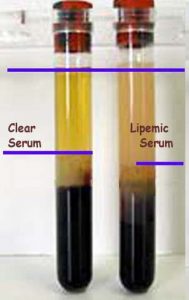Ron Hines DVM PhD
 See What Normal Blood & Urine Values Are
See What Normal Blood & Urine Values Are
 Causes Of Most Abnormal Blood & Urine Tests
Causes Of Most Abnormal Blood & Urine Tests
The Lipemia Index Of Your Pet’s Blood – (Lipemic Blood Sample)
Some clinical chemists and laboratories do not differentiate between the cloudiness of blood serum samples that contain large amounts of tiny fat droplets (= lipemia) and those that contain tiny grains of other materials (= turbidity). Others do. If you consider them to be the same, read the sources and causes of turbidity and add them to this explanation.
Shake some olive oil in a bottle of water, and you will see that it becomes hazy with tiny droplets of emulsified oil. The same thing happens in your dog and cat’s blood after an oily meal – its blood serum (or plasma) becomes milky.
Like a hemolyzed blood sample or a sample that just stood too long at room temperature, lipemia can throw off several of your pet’s blood value reading. (read here) To avoid lipemia and other possible collection problems, I suggest that you fast (no food) your cat or dog overnight before your veterinary visit. If this is not a medical emergency, call ahead to your vet’s office to find out when lab pickups are or when their techs will have time to analyze your pet’s sample. Find a quiet time slot at the clinic, so your pet will remain calm or have a house call vet visit you and draw the sample.
Some laboratories report back the degree of lipemia in your pet’s blood sample using an index. It roughly follows the triglyceride level in your pet’s blood at the time the blood was drawn (<30 = no lipemia or turbidity, 30-60= slight lipemia or turbidity, 60-120=moderate lipemia or turbidity, >120=marked lipemia or turbidity).
The higher the number, the more likely for other blood values to be inaccurate. Marked lipemia can falsely elevate your pet’s bilirubin and hemoglobin readings, and falsely decrease your pet’s blood electrolyte ion readings (=sodium, chloride, phosphate, calcium and, to a lesser degree, potassium).
Many central laboratories have methods that can improve the accuracy of tests when the serum sample is lipemic (ultracentrifugation, lipid clearing agents). That is one of their advantages over table-top analytical machines. Read about that here.
Reasons Why Your Fasting Dog Or Cat Might Still Have Lipemic Blood Serum:
All the health problems that elevate the fatty components of blood even when the pets are fasting can predispose them to lipemic serum. They include:
Diabetes in dogs and in cats, pancreatitis in dogs and in cats, hypothyroidism in dogs, Cushing’s disease, failure to eat/starvation as in hepatic lipidosis, corticosteroid medications and kidney disease (nephrotic syndrome) can all occasionally be the cause of lipemic blood serum.
Your pet’s lipemia index (lipemia) might also increase in late pregnancy, early milk production (lactation) or when Depopovera® is given to cats.
More rarely, genetic tendency to high blood fats (familial hyperlipidemias and hypertriglyceridemias, particularly in miniature schnauzers, Brittany Spaniels and beagles) have been responsible for persistently lipemic blood samples.
Genetic defects in the fat metabolism in certain cats (=hyperchylomicronemia in Siamese cats, domestic short hair and Himalayan cats), and growth hormone disturbances in cats (acromegaly) are some other possible but uncommon causes.
DxMe



